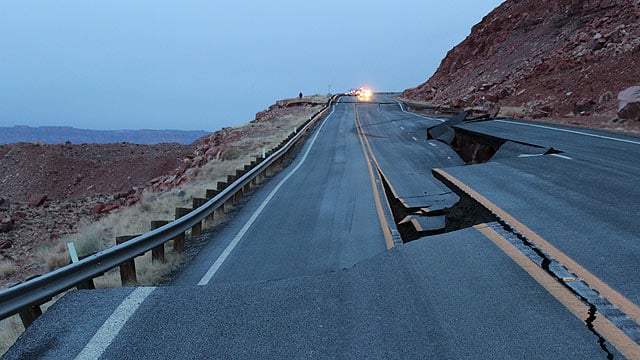The Great Collapse: Crust weakening, slipping, and collapsing across the planet

February 23, 2013 – Geological event rips road in Arizona: A 150-foot section of U.S. 89 south of Page that buckled and sunk four feet Wednesday might have been caused by a “geologic event,” according
to the Arizona Department of Transportation. The road collapsed at mile
post 526 just 2.5 miles north of the intersection with U.S. 89A, about
25 miles south of page, according to an ADOT spokesman. He said the
incident was not related to the weather. The road was closed in both
directions and there was no estimation when the highway would reopen,
said an ADOT spokesman. ADOT officials said northbound U.S. 89 was
closed at the U.S. 89A junction, which takes motorists west toward Jacob
Lake. In Page, U.S. 89 was closed at the junction with State Route 98.
Northbound motorists were being routed to U.S. 160 east to State Route
98, and north on SR 98 back to U.S. 89 in Page. The detour is about 45
miles longer than the direct route, the spokesman said. The Coconino
College campus in Page was also closed because of the road closure. DPS
reported a number of collisions within the collapse, but none appeared
to be serious. No injuries were reported. No other information was
immediately available.

UK nightmare: The
landslip, described as one of the worst in living memory, has twisted
tracks in the area, disrupting train service to and from the region for
untold months.
Massive landslip in the UK:
There is no end in sight to the severe disruption a landslide has
caused for Scunthorpe area rail passengers, according to a leading rail
expert. Sim Harris, managing editor at Railnews, the national newspaper
for the British rail industry, says the landslide near Hatfield Colliery
that is affecting thousands of North Lincolnshire rail passengers is
the worst in decades. The disruption for passengers travelling between
Scunthorpe and Doncaster has seen their journeys extended by up to an
hour as they take buses to and from their destination. Work cannot begin
repairing the track until the landslide stops moving – and officials at
Network Rail say they have no idea when this will be. Mr Harris said:
“Landslips themselves are not that uncommon and over the last year there
have been quite a few because of the heavy rain that we have had.
“There have been a lot of landslips that have not been rail-related, but
some railways have been affected. This one is certainly the worst in my
recollection and you have to go back a long way to find anything of
this nature. In 1953, there were floods along the east coast service
near Newcastle, where bridges were washed away. I don’t think I have
seen anything like this in recent memory. I don’t recall anything as
serious as this. There is no end in sight. He says repairing the line
will not be an easy task. Until the ground stops moving, there is not
much that Network Rail can do – their hands are tied. When it stops
moving, it will take more than five minutes to rebuild four tracks of
main railway. There are junctions that are involved which make it much
more difficult.”



Every year it seems, PCH Hwy 1 in California loses more road as well. It is so small as it is, but the most beautiful road in California along our coast. I hope to photograph it in full one day...
ReplyDeleteI hope to see you photograph it in full one day :)
Delete